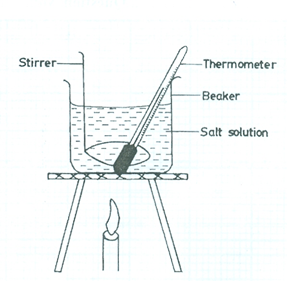Alternative A
Question 2A

- Measure 200 cm3 of water into the beaker.
- Heat the water until it boils steadily for about 2 minutes.
- Read and record the boiling point bo.
- Add table salt of mass M = 10.0g to the boiling water and stir continuously until another boiling point bi is attained.
- Read and record bi.
- Evaluate θi = (bi - bo).
- Using the same mixture, repeat the procedure four more times by adding 10.0 g of salt each time to give the cumulative mass Mi of salt as 20g, 30g, 40g and 50g.
- In each case, allow the mixture to boil steadily for at least 2 minutes then read and record the boiling point bi.
- Tabulate your readings
- Plot a graph with Mi on the vertical axis and θi on the horizontal axis.
- Determine the slope, s, of the graph.
- State two precautions taken to ensure accurate results.
You are provided with a beaker, a thermometer, a stirrer, stop watch/clock, measuring cylinder, table salt, water and other necessary apparatus.
(b) (i) Define the boiling point of a liquid.
(ii) What effect do impurities have on the boiling point of a liquid?
Observation
Part (a) Majority of the candidates avoided this question. The few candidates that attempted the question performed averagely. Many candidates recorded ridiculous values for the boiling point of water at bo and bi.
Part (b) Candidates’ responded poorly in this part as many candidates were not able to define correctly the boiling point of and the effect of impurities on the boiling point of a liquid.
The expected answers are that candidates should:
e.g.
- Avoided splashing of water
- Water stirred gently
- Avoided parallax error on the thermometer/stopwatch/stop clock/measuring cylinder
- Avoided zero error on stop watch/stop clock
- Repeated readings shown on table
- Ensured thermometer did not touch the beaker
b(i) This is the temperature of a liquid at which its saturated vapour pressure equals the external atmospheric pressure
(ii) Impurities increase/raise the boiling point of a liquid